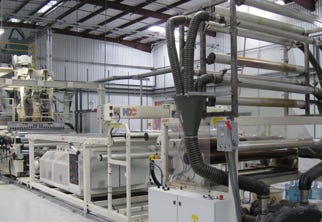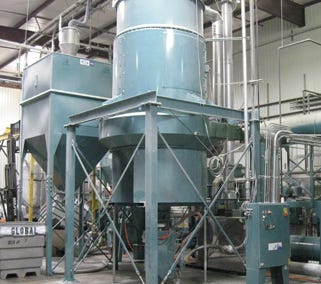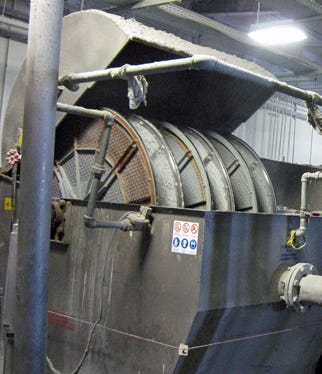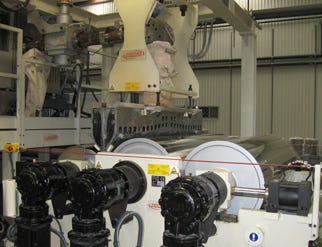
G - Ext - overali.jpg
Global P.E.T. Inc., Perris, CA, turns 60 million lb of used PET bottles per year into recycled PET (RPET) flakes. The company converts some of these flakes into extruded film and thermoformed trays and sells the remainder to other converters. Global P.E.T. has three extrusion lines and three thermoforming lines.
Global P.E.T. was founded in 1997 by owner and president Nadim Bahou to grind clean PET bottles. The company later moved into processing uncleaned PET bottles sourced from California's 5-cent recycling program.
"There wasn't enough clean PET bottles to meet my needs," says Bahou. "So I decided to install washing systems and expand into running unwashed bottles. In 2009, I signed a 10-year long-term a
G - crys-dry.jpg
greement with the Plastic Recycling Corp. of California for an annual supply of 60 million lbs of post-consumer PET bottles."
Most of the equipment at Global P.E.T. is supplied by Amut, including the wash lines, the three extrusion lines and two of the thermoformers. Amut says that they believe that they are the only company in the world that provides all three of these technologies.
"Amut is very well known in Europe and it was very aggressive in pricing," says Bahou. "I started out by buying their wash line, and I was very satisfied with it, so I bought a second wash line from them. When I decided to add extrusion operations and then thermoforming, I went with Amut."
The bottles are received at Global in 1,000-lb bales. Because these are from commercial recycling facilities and have not been cleaned in any way, the bales contain a significant amount of foreign material, such as plastic bags and other kinds of plastic bottles besides PET.
Therefore, the first stage in the operation at Global is to break the bales and place the loose material on a conveyor that transports it past workers who remove obvious foreign material. Next the material is transported through a metal detector. and any metal is blown off of the conveyor.
Separate clear and colored bottles
The remaining bottles then travel through a MultiSort IR/ES Combo sorting system from National Recovery Technologies Inc. that separates the clear bottles from the colored bottles. The system combines IR advanced polymer sorting with high precision color sorting into one platform for high-accuracy, low-cost sorting of post-consumer plastic bottles.
The MultiSort system uses high-speed infrared detection technology and precision color sensing technology to rapidly identify the signatures of different polymers from th
G - filter.jpg
eir infrared spectra and determine their colors. The non-PET containers are diverted from the conveyor.
The system features an easy-to-use integrated graphic control panel with a color touch screen and factory diagnostics, adjustments and upgrades via remote modem connection.
The PET bottles, many of which still have labels and/or caps attached are pneumatically conveyed to a grinder. The resulting PET flakes, along with ground up labels and PP closures, then enter a four-stage wash line from Amut.
The first stage transports the dirty flakes to the pre-washing trough, where the PET, which is heavier than water, sinks, while the paper, PP and other debris float on the surface and are carried out of the system with the water.
A screw conveyor in the bottom of the first stage transports the PET to the second stage.
This is Amut's patented "friction washer," which removes any label residue, remaining glue and other impurities that are sticking to the flakes. The friction washer is a long tank containing a screw in the bottom and paddles that generate the friction.
This subjects the flakes to an intense, but non-destructive friction action in 195 deg F water that contains caustic soda and other cleaning chemicals. Computer control of the temperature and percentages of cleaning chemicals ensures that any remaining labels are reduced to pulp, and the hot water removes any glue remaining on the PET flakes by melting.
The friction action and the residence time of the flakes in the friction washer can be adjusted to achieve optimum washing performance. The water leaving the friction washer is cleaned in a continuous system that uses large rotating discs of filter material to remove fines. The water is then recycled back to the washer.
The PET is removed from the bottom of the friction washer by a screw and is then transferred to a screw in the bottom of the third stage tank, which contains a counter flow of hot water. This final hot rinsing operation prevents the glue from reattaching itself to the PET flakes and also removes most of the caustic soda from the flakes, which reduces their pH. The flakes travel to a flotation tank where lighter materials, such as PE and remaining label material, will float, while the PET sinks.
The PET flakes are then delivered to a centrifuge that removes any remaining water. This is followed by a dryer and a final grinding step. The flakes are stored in 1,000-lb bulk bags to await sale or to be transported to Global P.E.T.'s extrusion operations.
Amut extrusion lines
When processing PET flakes, the feedstock for the three Amut extruders consists of 100 percent RPET flakes and must be dry before entering the melt phase or the intrinsic viscosity of the film is degraded. Therefore, Global P.E.T. installed a system from Universal Dynamics Inc. that crystallizes, then dries, the clean RPET flakes.
Flakes from the Amut washing plant grinder are dumped from the bulk bag into a floor hopper and are pneumatically conveyed to the crystallizer where they are heated by hot air to about 280 d
G - die.jpg
eg F.
Bars on a rotating vertical shaft in the crystallizer vessel agitate the material and prevent any agglomeration. The flakes enter the hot-air dryer, which operates at about 350 deg F, and then continue to the single screw extrusion line, which was supplied by Amut.
In an operation typical of the three lines, the flakes are metered from an overhead hopper into the Amut extruder operating at about 550 deg F. If colored film is being produced, coloring materials are metered into the flakes as they enter the extruder. The molten material passes through a screen that removes metal contaminants and discharges into a gear pump that feeds the molten material into the flat T die.
The extruder consists of a horizontal auger inside of a heated barrel. The auger forces the molten RPET out through the die onto water-cooled quenching rolls. These are followed by six additional rolls that keep the film aligned properly and at a constant tension to minimize film variations across the web as the film is air cooled.
The film then travels through a film thickness controller from NDC Infrared Engineering Inc. that travels back and forth across the web. After the thickness gauge, the edges of the film are trimmed, after which the film travels through a silicone bath followed by an air blower from Sonic Air Systems Inc. that dries the film. The thin silicone coating on both sides of the web serves to prevent the trays that are made from this film from sticking together when they are stacked.
The film then passes through an accumulator section that consists of a series of rollers. In normal operation, the film passes through these directly, but if the there is a down-stream stoppage, for example, to change a winding roll, the accumulation rollers rise so that the film makes a series of vertical passes to accommodate the film and enable the machine to continue to operate. The rollers slowly return to their normal alignment when regular operation resumes.
The final operation of the extruder is to wind the film on a cardboard core. The unit at Global P.E.T. has two winding rolls, one after the other.
When the winding roll being used is filled, the operator changes over the film to the other roll. As mentioned previously, the extruder does not stop during this process. While the film is being transferred, the film is accumulated.
Depending on production requirements, the full 66-in. width of film can be wound on one core, or if narrower film is required, the web is slit and the film is wound on multiple side-by-side cores.
The extruder is controlled
G - thickness gage.jpg
by a Simatic PCS 7 system from Siemens. This system, which includes an HMI for the operator, automatically sets and controls the operating parameters when the operator inputs the product name or code. These include the line speed, temperatures and web tension as well as setting the weigh feeder output and the speed of the gear pump and the extruder.
Global offers fully recycled containers
In 2009, Global P.E.T. introduced a food container made from 100 percent recycled PET.
The containers are suitable for takeout, salad, snacks, deli items and entrees not to exceed 165 deg F. Global PET was granted an FDA Letter of Non-Object in 2009, which allows the containers to contact food products directly. According to Bahou, this is an industry first for containers made from recycled PET. Four sizes of the containers are available in hinged and single-tray configurations and in clear, black and green.
The RPET containers are being used by Taylor Farms California, Inc., Salinas, CA, for its retail products. Taylor Farms manufactures and delivers fresh produce for the retail, foodservice and deli industry. It offers salads, cut fruit and vegetables.
Global P.E.T. manufactu
G - theroform.jpg
res the containers on three thermoforming lines in its plant. In these operations, RPET is pulled from a roll that is installed at the inlet of the machine. The film is heated to forming temperature and is then automatically formed into molds that shape the trays at a speed of about 30 cycles/min.The trays are then transported through a hole-punching section and finally a "steel rule" cutting press. The trays are split apart in the next zone of the machine after which they exit and are automatically assembled in stacks up to 50 units high.
"Amut has provided great service for all of the equipment we bought from them," says Bahou. "They even had highly specialized people come here from Italy if I needed their help."
Amut S.p.A, 905-652-9034. www.amut.it
National Recovery Technologies Inc.,
800-467-4678. www.nrtsorters.com
NDC Infrared Engineering Inc.,
626-939-3887. www.ndcinfrared.com
Sonic Air Systems Inc., 714-255-0124.
www.sonicairsystems.com
Siemens, 800-743-6367. www.usa.siemens.com
Universal Dynamics Inc.,
703-490-7000. www.unadyn.com
About the Author(s)
You May Also Like


